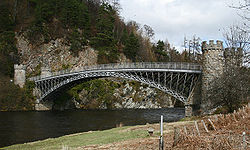Craigellachie Bridge
| Craigellachie Bridge | |||||||
| Location Map ( geo) | |||||||
 | |||||||
| |||||||
| From: | Craigellachie | ||||||
| To: | Rothes | ||||||
| Location | |||||||
| Craigellachie | |||||||
| County | |||||||
| Moray • Banffshire | |||||||
| Highway Authority | |||||||
| Moray | |||||||
| Opening Date | |||||||
| 1814, 1972 | |||||||
| Additional Information | |||||||
| |||||||
| On road(s) | |||||||
| A941 | |||||||
Perhaps the Spey's most famous bridge, the original Criagellachie Bridge was built by Thomas Telford in 1814 as part of his Highland Roads & Bridges Commission. Today it has been replaced by a much longer Concrete viaduct, the necessity of which shows what a masterpiece Telford's work was!
Telford Bridge
Telford's old category A listed bridge at Craigellachie is often known simply as Telford Bridge, whether in reverence at his skill or to differentiate it from the other bridges in the village! It is the oldest wide-span Iron Bridge in Scotland, and therefore one of the oldest in the British Isles, dating back to 1814. The Span is 150foot in width, and crossed with ease by the graceful segmental arches of Cast Iron. The deck is then supported by lattice work Spandrels. However, the ironwork alone would not make the bridge so photogenic. It spans between a pair of Granite Abutments, surmounted by castellated turrets on either side of the roadway. In order to strengthen the structure, the abutments are not vertical as is often found, but sloping down towards the water, much as the keystones of a Stone arch would.
Add to all this beautiful craftsmanship the fact that the west abutment seems to be built out of the very cliff that the river has cut, and for a second the bridge appears to cross to a rock wall. In fact Telford's team had to cut a ledge into this cliff to carry the road around to the more level ground. The choice of site may therefore be bought into question, but the bridge sits at one of the narrowest points of the river - bearing in mind that the span was already 'pushing the boundary'. It is also one of the narrowest points in the flood channel and the difference in height of the banks to the north would have meant a much longer structure, as the flood capacity of the river is immense. Telford is known to have followed local advice about the possible extent of floods, which led to his bridge surviving the Muckle Spate of 1829.
All of this goes to show how much effort had to be invested in taking the road across the River Spey here, and indeed almost anywhere in its lengthy journey from the Mountains in the west to Spey Bay on the Moray Firth. The fact that the bridge still stands, and is the second oldest surviving bridge downstream from Laggan just goes to show the skill of Telford and his team.
The ironwork of bridge was cast at Plas Kynaston, Ruabon, Denbighshire, as the plaque says, with the sections shipped to Spey Bay (The Caledonian Canal was not yet complete) and then hauled down Strathspey in Waggons by Horses, with the bridge opening to the public in November 1814. It was based on the earlier bridge of the same design that Telford built over the Kyles of Sutherland at Bonar, and after proving successful, Telford used the same basic design principles for a number of bridges around the country. The bridge was strengthened in 1902, restored in 1964 in a joint project by Banff, Moray and Nairn County Councils, and finally replaced in 1972.
On the bridge's 200th anniversary in November 2014 a local Friends of Craigellachie Bridge group was launched, with the aim of raising awareness and funds to help preserve the bridge into the future. Moray Council estimate that restoration work required at this time will cost around £400,000.
The Modern Bridge
How could any modern structure live up to the spectacle of Telford's Original? The answer is, of course, that it couldn't. As a result, the modern bridge carrying the A941 north is a rather plain steel and concrete viaduct of three spans, the southern one crossing the river itself. It has tactfully been built at some distance from the old bridge, to maintain its setting, and there is plenty of planting to disguise the utilitarian structure.
The structure is a long box girder bridge, opened in October 1972. The two steel box girders were assembled on the embankment to the south of the river and slid into place over the piers, before the concrete deck was constructed on top. For some years after it opened, the A941 took a sharp turn towards Craigellachie village off the embankment, which was later extended to form the village bypass.
Maps
|
The old bridge in 1962
|
The new bridge in 1972
| |
Links
Historic Scotland
RCAHMS
Craigellachie.org
BBC News
- Honour for iconic Scottish bridge (04.07.2007)
- Iconic Craigellachie Bridge stamp honour from Royal Mail (05.03.2015)
- Bid to trace owners of iconic Craigellachie Bridge (10.09.2017)
| Craigellachie Bridge | ||||||||||
| ||||||||||
|






